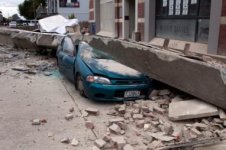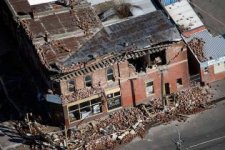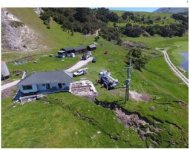... the Good Friday Earthquake, which was something like a nine point two, and lasted something like five minutes.
Damage was extensive, of course, not even counting that from the resulting tsunami. But, if you look at some of the pictures, you'll see largely intact buildings, whose major damage was largley due to the ground underneath them collapsing.
In other words, it wasn't necessarily the shaking that did them in (although that did indeed cause considerable damage) it was the fact the ground beneath them essentially liquified and sloughed.
Umm, you forgot to mention that there
weren't any buildings in Anchorage at that time

My two-story high school was halfway destroyed, they had to take the second floor off and rearrange it. The L street apartments were a twisted wreck for several years, before they pulled the building down. There was one other tallish concrete structure that was destroyed but I forget the name. Anchorage was the frontier then

Anything higher than two stories and not made out of nailed-together pieces of wood ? Pretty well destroyed. Penney's fell down, L street ruined, much of downtown (all three blocks of it) was wrecked. Wally Hickel got a lot of acclaim for putting up a four-story building later, to "proves his faith in Alaska."
btw, they have built on the two blocks of Turnagain across the street from us that disappeared into Knik Inlet. I guess the danger of earthquakes has passed now

And in that kind of case, it doesn't matter how well you've anchored your lathe, or how deep your slab is. It's gonna go no matter what.
That's really the bottom line. In a real erthquake, just get outside away from falling stuff or kiss your ass goodbye. In a city, from the Big One, there's nothing you can do. The roof falling
on top of the lathe will be a bigger problem

I am most concerned about a relatively common 4-5 earthquake. A quake of that strength doesn't break the house (it creaks and moves around quite a bit) but it could tip the lathe over.
Doubt it. The Battle of the Bay quake just made my machines rattle and slopped sulfur oil all over the floor. Made some cracks and stuff but nothing was in any danger of falling over. And yeah, you could see waves in the street but lathes are tough. They don't tip over that easy.


 My two-story high school was halfway destroyed, they had to take the second floor off and rearrange it. The L street apartments were a twisted wreck for several years, before they pulled the building down. There was one other tallish concrete structure that was destroyed but I forget the name. Anchorage was the frontier then
My two-story high school was halfway destroyed, they had to take the second floor off and rearrange it. The L street apartments were a twisted wreck for several years, before they pulled the building down. There was one other tallish concrete structure that was destroyed but I forget the name. Anchorage was the frontier then 





